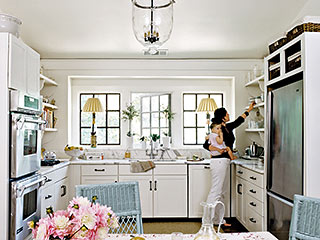In December we visited a lecture about interaction between arts and sciences, namely between (primarily) visual arts and (again, primarily) multimedia studies (Russian page). The lecture was given by Asya Ablogina, who turned out to be a nice girl. Although she lacked any technical background, she was doing well. Surprisingly, there is a lot of artwork that exploits technical support in a witty manner, which I was unaware of, so the lousy stuff exhibited in the Moscow Museum of Modern Art is not everything one can do in this field!
The most interesting part was Asya's exposition of some masterpieces. Most of them were presented during 2009 Science as Suspense exhibit in Moscow (Russian). Nicolas Reeves is a famous Canadian architect, also known for his work on modelling biological systems. He used the output of biologically-inspired computer algorithms (such as genetic algorithms) to draw pictures. In Moscow he presented a project called Marching Floating Cubes: massive but light cubes float in the air. Their movements are controlled by tiny fans, although any little gust of wind can affect the movement. Each cube is equipped with an on-board computer, which helps to avoid collisions. The implemented algorithms are simple but stochastic, hence the behaviour is unpredictable. They are said to move like animal creatures. Here is the video:
A similar project was developed by Paul Granjon. He also tries to gift robots with animal behaviour. In the video below, robots are sexed, i.e. they are able to locate robots of the opposite sex and eventually end up in coitus. Another Paul's robot (the Smartbot, photo) creeps over the restricted space and always grumbles (just like Marvin!). I also enjoy the way Paul speaks:
The real idol in the sci-art community is Stelarc (see also his homepage, although it takes balls to get through the welcome page :). His talent is recognized by both scientists and artists (it is enough to mention he's an Honorary Professor of Arts and Robotics at Carnegie Mellon). He's best known for his experiments on his own body. For example, during a performance he allowed to control his body remotely over the Internet by muscle stimulation. Probably his favourite project is Prosthetic Head, which is in fact a 3D model of his own head. The head is learned from Stelarc's behaviour and speech, so it is able to communicate with people using colloquial information as well as non-verbal cues. It is interesting to try it in practice, but here is just a non-interactive demo video:
Stelarc is probably the only person on Earth who has three ears. In 2007 surgeons implanted an ear into his arm! It is not functioning now (just a piece of skin), but he plans to install an audio receiver into the ear and broadcast everything he hears over the Internet. I definitely recommend to look through his projects, there are decent ones.
Asya also presented her own works. She focus on different photographic techniques such as overexposure. Here are photos from her project Canvas of the Road compiled in a video. There is a play of words in Russian: the single word for canvas and road surface. On these photos car traces look like painter's strokes:
Another Asya's project is a short film series called Habitat. She showed only one episode with the title Habitat: MSU Main Building. The film was about a girl who is a PhD student in Moscow State University and described her place: a standard 8 sq.m. dorm room. The narrative was full of expressive epithets and metaphors about that awful room: the girl felt like in a cage, she also didn't like shared bathroom, etc. It's funny, because I live in a similar PhD student single room, and I'm quite happy with it, since I've been living 5 years in a shared room before. :)
The second lecturer, Vladimir Vishnyakov, presented his project called The Museum of Revived Photography. He used the photos of the XIX century to create image-based animation. The idea is technically simple: first segment people from the background, then use inpainting techniques to restore the background behind them, and animate the movements, but Vladimir referred to a programmer he works with as a real genius. In fact, all the stuff I post here varies from easy to moderately complex (except of Stelarc's projects), so you can do something similar too. The main problem is to come up with the concept. Come on then! ;)









